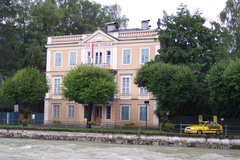The Franz Lehár Collection in Bad Ischl, Austria
Sandra Föger
Thursday, April 30, 2020

We have received the following from our RISM contributor Sandra Föger (RISM Austria):
April 30, 2020 marks the 150th birthday of Franz Lehár. His works are still very much alive on stages worldwide even today. His operettas such as The Merry Widow, The Count of Luxemburg, Gipsy Love, Paganini, Der Zarewitsch, The Land of Smiles, and Giuditta are among the most performed of the genre.
As a main representative of the “Silver Era” of operettas, which is marked by an economic boom and an increasing internationalisation of the Viennese operetta, Lehár composed over 20 operettas. Among these is the work that was his international breakthrough and which at the same time created a new kind of “dance operetta,” The Merry Widow (premiere in 1905). With additional new formats such as the “lyric operetta,” Franz Lehár left a significant mark on the development of the operetta as a genre. For example, he dispensed with a usual happy ending in Paganini and relied on operatic sentiment and pathos.
The operetta composer owned a villa in Bad Ischl, near Salzburg (see image). In his will, he left the villa and its contents to the city under the condition that a museum be established out of it. Beginning in 1902, Lehár had started spending his summers in Ischl, in the Salzkammergut resort district, which was where the Viennese theater scene spent its summers. Operetta composers, librettists, singers, directors, and theater owners would converge in Ischl to make and maintain contacts and plan new projects. In 1910, Lehár bought the villa that had belonged to the Duchess of Sabran. He spent almost every summer at his villa until his death there on 24 October 1948.
The music collection in Bad Ischl includes autograph manuscripts, sketches, sketchbooks, fragments, printer’s copies, and methods. This part of the collection, with the RISM library siglum A-ISCHsta (overseen by the town of Bad Ischl), is not yet open to the public.
A comprehensive music collection from the Viennese publisher Glocken, which Lehár founded himself in 1935, joined the music collection at the Lehár Villa in the 1990s. Its large portion of printed items (scores, orchestra material, piano reductions, libretti, director’s books, etc.) show how popular Lehár’s works were and the variety of ways they were employed: arrangements for military bands, salon orchestra, “Viennese” quartet, single editions, etc. This collection is almost completely cataloged in RISM with the siglum A-ISCHlv (Lehár Villa Bad Ischl).
So far, over 700 shelfmarks for music in the Lehár Collection have been documented in the RISM database. The bulk of the collection can already be searched by the public. The entire collection should be in RISM by the end of the year.
Image: The Franz Lehár Villa in Bad Ischl. Photo by Toffel from Wikimedia Commons.
Share Tweet EmailCategory: Library collections

